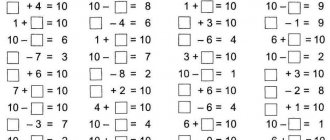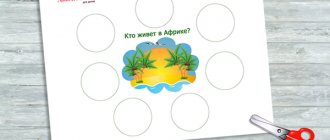We offer for you and your preschool children 5-6 years old examples for counting to 10 in colorful pictures. Such examples are interesting to solve. Simply print out the free worksheets and let your child decide. By devoting 20-30 minutes a day to counting and mathematics, 2-3 times a week, you will perfectly prepare your preschooler for school.
On our website you can download math assignments for free and print them out. Most of the tasks are decorated with colorful drawings and the child will find it interesting to study.
These materials are perfect for children to review the material they have covered during the summer holidays. Repetition of counting, logic, solving examples of addition and subtraction.
What are math puzzles?
These are entertaining tasks with game elements. Such tasks do not require deep mathematical knowledge and special training; rather, you will need intelligence and observation.
There are a lot of math puzzles. These include logical puzzles, problems with numbers and pictures, paradoxes and probabilities, and much more. They can be simple, which the child can easily cope with on his own, or complex, when he needs the help of his parents.
Development and education of children from 2 to 11 years old in a playful way
Start practicing right now
Start practicing
Examples within 10
Gradually, the child will be better and better at calculating within 10. To learn how to “crack” examples like nuts, you need to solve a lot. But simply solving the same type of examples is boring. Math should be interesting!
So that your child can practice writing examples at any time, we have come up with ready-made tasks for you. Just download, print and get started!
How we play math
We have been playing math games with our children since early childhood, from the age of 3. The first was the game “Kitten's Journey”.
My son picked up a toy kitten, we sat down in front of the globe, and the journey began. We imagined that a fast train was rushing a kitten from our city across the entire continent, and tried to imagine the pictures that the kitten sees. Along the way, the kitten had to draw a path through a maze, or collect precious stones in a cave, or help a little beaver build a house. Of course, our son helped the kitten complete the proposed tasks. Sometimes we “boarded” into a rocket and flew to the stars, exploring them, the planets and space itself. Sometimes we shrank down to microscopic size and traveled through the blood vessels of the human body, studying the composition of the blood and the location and properties of the body's organs. The son grew, the tasks became more complicated. His next favorite game was Lego Programming. We drew labyrinths through which, by issuing commands “forward”, “backwards”, “right”, “left” with four colors of Lego blocks, we had to guide a robot or car. At the same time, there were many games for classification and sorting of objects.
Then a math club was organized for children aged 4-6 years old - we spent two years together playing and learning new things. Then our daughters were born, after them new games appeared and the old ones were enriched. Finally, we collected what we had accumulated over ten years of study into a book. Each chapter begins with a story about how dad or mom play with their children - Kolya and Katya. You can discuss the games from the story with your child, you can play them, or you can complete the tasks suggested at the end of the chapter.
Here are some games from this book.
Four cars
An example of a visual game for sorting objects by color.
- Dad, I'm bored! Play with me! - Kolya called his father. - Fine. What are we going to play? - In Lego. - Amazing. Would you like me to show you something interesting? - Dad sat down opposite Kolya and poured out all the Lego between them. Then dad took four trucks from the shelf and suggested: “We have Lego parts in four colors.” Let's arrange them among the cars: the first one will carry red parts, the second one will carry blue parts, and the next two will carry yellow and green parts. We will take the parts to the other end of the room and there we will build four garages from them: red, blue, yellow and green.
Robot in the maze
This game is aimed at developing algorithmic thinking. This is how we learn to solve complex problems using a sequence of simple actions.
- Kolya, imagine that you are a robot. Stand here, on the arrow showing the entrance to the labyrinth. You should only walk when you hear the command, and take one step at a time in the direction indicated to you. Katya will manage you.
The guys were happy and agreed. Then dad put Kolya in front of the entrance to the maze, and Katya next to Kolya, and said that the robot only understood simple commands: forward, backward, right and left; and that at each command he takes a step in the indicated direction and freezes, waiting for the next command. And that he cannot enter squares on which there are obstacles.
Multi-colored candies (logic problem)
Mom: - I bought you three candies: green, red and yellow. For Katya - not green, for Kolya - not yellow, for dad - neither red nor green. Guess which candies I bought for whom.
Perform developmental exercises from Ikyusha
Mathematics
Reading
The world
Logics
English language
Puzzle “Card, please”
Look carefully at the credit card numbers. What three numbers should be written in place of the question? Already have any guesses?
We hope you completed the task quickly! And the next puzzle is already waiting for you.
Puzzle “Chairs”
The teacher asked the students to arrange 9 chairs along the four walls of the classroom so that each wall had three chairs. The students completed the task. Can you?
Puzzle “House number”
Hardworking builder Evgeniy arrived on site earlier than the others, but forgot the house number! We know that the house is located between plots 88 and 98. Can you help Evgeniy and tell him the number?
Bullseye Puzzle
Do you like to watch archery competitions? It's so exciting! Look, both archers have already performed, let's count how much archer B scored? We know that shooter A scored 54 points, and points are earned proportionally from the end: 1, 2, 3...
Puzzle “Mom and Daughter”
In this task you need to guess the ages of the mother and daughter. We know that if you add up their ages, you get the number 66. And if you swap the numbers of the mother’s age, you get the exact age of the daughter. Moreover, the mother is no older than 59, and the daughter is no younger than 7. Guess how old they are?
Puzzle “Hurray, fireworks!”
Look how beautiful the fireworks are! And not just one, but six! But one of them was not launched, determine which one?
Puzzle “Mathematics”
The task is simple - fill out each line and column so as to get the specified result at the end. You can only use numbers from 1 to 9 so that there are no repetitions in each line.
Puzzle “Wise Old Man”
The father of three sons made a will so that after his death the children would divide their father's herd of camels like this: the eldest son would take half, the middle son only a third, and the youngest son would get only a ninth. The father died, leaving a herd of 17 camels. Unable to divide the animals, the children asked the wise old man to help them. The elder agreed and, arriving on his camel, divided the animals according to his will. How did he do it?
This puzzle is a variation of Italian mathematician Niccolò Tartaglia's famous "Difficult Inheritance" problem. He went down in history as the scientist who discovered the solution to cubic equations.
Puzzle “Counting fruits”
Where else if not in a store to train counting skills? Let's buy 2 sweet aromatic oranges? How many coins will you need to pay for them? Look at the picture and count.
Examples in pictures
Examples in pictures are suitable for beginner mathematicians. A visual image will help the child better see the cause-and-effect relationship of changes in quantity.
Download worksheets for solving addition and subtraction examples.
You will find even more examples for preschoolers in the section Adding and Subtracting








